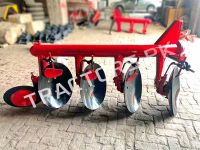Disc ploughs are useful during the initial phases of farming as they prepare the soil for plantation. A disc plough helps bring fresh nutrients to the soil’s surface by overturning its upper layer. It buries weeds and leftovers of previous crops. The soil can withstand heavy loads after a disc plough aerates it for it to hold moisture better.
Uses and benefits of Disc Plough Farm Implements
• Works well on hard and dry soils
• Rides over stumps instead of penetrating them
• Effective after harvesting is done and when the ground becomes hard
• Used for deep ploughing
• Longer-lasting as compared to a mouldboard plough
• Operates in non-scouring soils
• Ideal for areas that are rain-fed as it checks soil erosion which occurs due to wind and water.
Disc Plough Technical Specifications
• Tubular seamless steel pipe frame
• 254 mm wide furrows
• 2, 2+1, 3, 3+1 furrows
• 300 mm maximum working depth
• 522 mm longitudinal clearance
• 508 mm furrow wheel diameter
• Weighs 360 kg (3 furrows)
• Can be mounted to a tractor of 50 to 85 HP.
• Bearing taper roller
• Plain discs 660 mm – inside and outside bevel
Why Disc Plough Popular in Africa
The reason why disc ploughs are popular in Africa is that usually, the soils there are filled with rocks buried within it, and disc ploughs can work easily over such soils. A disc plough works with far more ease on hard soil surfaces in Africa, as compared to a mouldboard plough. It also cuts deeper.






